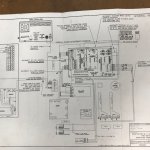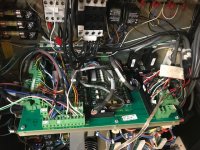M. Moore
Titanium
- Joined
- Jun 8, 2007
- Location
- Vancouver Island, B.C. Canada
As the title suggests I am having a problem with an incorrect voltage to the VFD on my vertical CNC mill. I thought it was a torque problem and posted about that twice and now after much research and testing I have narrowed the problem down to the voltage signal that controls the motor rpm. It is an Anilam 3000 control that was an upgrade from the 1000 series in about 2010. (previous owner)
The VFD uses 5 volt or less input to alter the spindle speed. I don’t know the exact range but it is something like 3-5 volts. After a call to the very helpful tech from HHRoberts (Topwell mill) I used a 3 volt transformer to apply power (actual was 4.2v) to the VFD (Baldor15H) and then turned on the spindle via the machine control. It worked fine and the spindle was smooth and steady at around 1700rpm.
So that tells me the VFD is working fine and I had already tested the VFD by using the keypad and starting the spindle, which worked perfectly.
So I re-installed the leads from the control to the VFD and tried again, no good as the spindle sounded terrible and when I checked the voltage it was over 12 volts. Not good at all. This was a new development as previously it had been working but pulsing up and down and would not go lower than 2000 rpm.
I checked the power supply voltage and it was spot on at 5 volts as it entered the system board. Then I checked the wires leaving the breakout board and it was 12+ volts.
So can anyone shed some light on what is happening on this system board that is causing the 5 volts to increase to 12 and or why it might have happened? Old age?
I tested the output of the leads to the VFD by attaching my meter and then choosing a speed on the control, it showed over 12 volts and did not change much when I used the spindle speed control knob to go down in 10% increments. Leads were not connected to the VFD for these tests.
This whole odyssey started when the end mill I was using slowed down in the cut like it was losing torque. Any help will be much appreciated.
Michael
The VFD uses 5 volt or less input to alter the spindle speed. I don’t know the exact range but it is something like 3-5 volts. After a call to the very helpful tech from HHRoberts (Topwell mill) I used a 3 volt transformer to apply power (actual was 4.2v) to the VFD (Baldor15H) and then turned on the spindle via the machine control. It worked fine and the spindle was smooth and steady at around 1700rpm.
So that tells me the VFD is working fine and I had already tested the VFD by using the keypad and starting the spindle, which worked perfectly.
So I re-installed the leads from the control to the VFD and tried again, no good as the spindle sounded terrible and when I checked the voltage it was over 12 volts. Not good at all. This was a new development as previously it had been working but pulsing up and down and would not go lower than 2000 rpm.
I checked the power supply voltage and it was spot on at 5 volts as it entered the system board. Then I checked the wires leaving the breakout board and it was 12+ volts.
So can anyone shed some light on what is happening on this system board that is causing the 5 volts to increase to 12 and or why it might have happened? Old age?
I tested the output of the leads to the VFD by attaching my meter and then choosing a speed on the control, it showed over 12 volts and did not change much when I used the spindle speed control knob to go down in 10% increments. Leads were not connected to the VFD for these tests.
This whole odyssey started when the end mill I was using slowed down in the cut like it was losing torque. Any help will be much appreciated.
Michael






